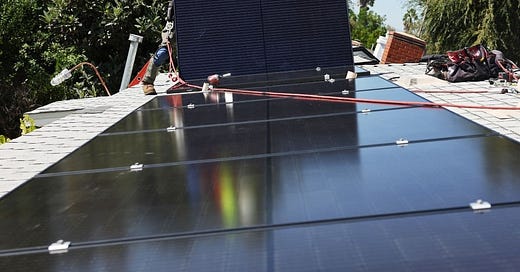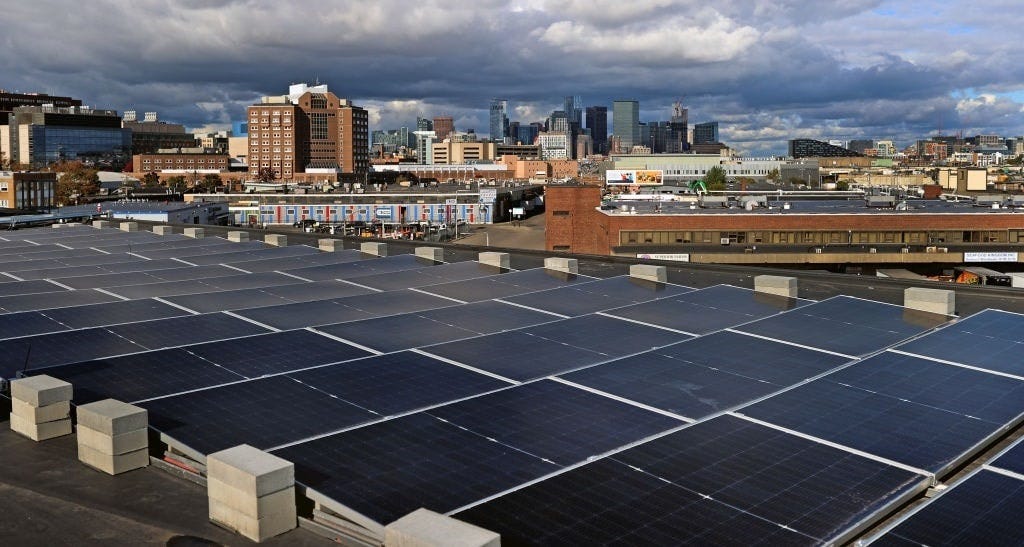What Would the Lorax Say About Solar Panels?
Dr. Seuss’ classic story skewers profiteers who abuse the earth in the name of protecting it.
(Photo by Mario Tama/Getty Images)
As the world’s leaders gather in Dubai for the 2023 “COP28” summit to discuss climate change, they would do well to learn a lesson from one of the 20th-century literary greats. In his iconic 1971 book “The Lorax,” Dr. Seuss poetically depicted an environmentalist called the Lorax who rebuked corporate profiteers ravaging expanses of “Truffula” trees to knit “Thneed” sweaters. Characterized as a “parody of a misanthropic ecologist,” the story’s entrepreneurial antagonist spurns the prophetic warnings of the tree-advocating Lorax (“I speak for the trees for the trees have no tongues”) in the name of “biggering” his operations until the entire Truffula forest is consumed.
A blunt warning about the environmental consequences of deforestation and consumerism, Seuss’ popular work seems to have anticipated the ecological destruction wrought by today’s faddish solar panel pushers. Now profiteers allied with NGOs, globalists, and government regulatory agencies seek to turn sand into gold at the expense of far more than Truffulas.
Solar Panels = Silicon
(Photo by David L. Ryan/The Boston Globe via Getty Images)
Some 85-90% of all US solar panels are manufactured using silicon. Renewable energy proponents persistently conceal this essential fact in their zeal to push dubious products at an ever “biggering” pace, in the name of staving off a climate crisis. Behind the veneer of virtuous proclamations and climate hysteria are those who demand an end to deforestation for agriculture (and less fossil fuels and coal for the grid) while rapaciously devouring both, turning lead – er – sand into gold.
Silicon = Sand
Silicon is made from sand, mainly in relatively unregulated China. One part sand to two parts carbon (coal, charcoal, or wood chips) is employed to achieve 2200 degrees Celsius (one-third the sun’s temperature) to produce silicon of acceptable solar-panel quality. Although most solar-panel websites obscure this fact, the Union of Concerned Scientists United States of America (UCSUSA) concluded:
“This process uses a lot of energy: producing 1 kilogram of metallurgical grade silicon requires 14-16 kWh of power, which is roughly equivalent to using your home oven for seven hours. Still, over their lifetimes, solar panels emit 25 times less carbon dioxide equivalent per kilowatt hour than coal-powered electricity.”
Lying to the Lorax
(Photo by Beata Zawrzel/NurPhoto via Getty Images)
But what of the other chemicals generated in manufacturing silicon solar panels? Could the “biggering” of the nation’s $33 billion (in 2021) solar industry investments disregard the actual science, much as Seuss’ thneed-makers ignored the common-sense warnings of the Lorax?
The hyped-up globalist 2023 “COP28” summit in Dubai Nov. 30-Dec. 12 will emphasize “enhanced adaptation action that builds resilience and reduces vulnerability, with a robust outcome.” This gobblygook is deliberately inscrutable, permitting corporate profiteers to cloak their activities by claiming “[s]cientists say both actions – rapidly expanding clean energy and quickly reducing the burning of CO2-emitting fossil fuels – are vital if the world is to avert more severe climate change.”
Equally bold, the website “ConsumerAffairs” claimed:
“While it is tough to label any sort of manufacturing process as environmentally friendly, solar panel manufacturing is about as environmentally friendly as it gets. This is largely because any sort of negative environmental impact caused by the manufacturing process can be completely offset by the decades of emission-free energy production solar panels provide.”
Polluting for Profits
On the contrary, rapidly expanding “clean energy” requires more silicon, thus more sand heated (and remelted), using massive quantities of coal or charcoal. The global call to end deforestation for growing food ignores that cows rebuild soils and sequester carbon: Burning coal, woodchips, or charcoal to melt sand creates chemically toxified panels that become toxic waste upon disposal.
The Union of Concerned Scientists seems entirely unconcerned about spewing volumes of putrid carcinogens into air, water, and soil in the carbon-centric pursuit to justify a process far more destructive than anything Seuss’ Lorax could fathom. This is reminiscent of tobacco industry misrepresentations that its products were “light,” “healthy,” “filtered,” or “safe.” The FDA regulated such claims as “health fraud” but is silent when solar-panel proponents deliberately hide the real environmental (and human health) impacts.
Crocodile Carbon Tears
Beneath the surface, renewable-energy stakeholders siphon fossil fuels from traditional uses to fund their more toxic alternatives. Climate alarmism demands more manufacturing – now. The UCSUSA concludes humanity must “speed [solar panel production] up because we need solar to play an ever-growing role in achieving our clean energy and climate goals.” The COP28 joint statement clamors to “adopt more ambitious policies to scale up renewable energy and develop financing schemes.”
Listen to the Lorax
Even children can follow the sand science to discern that silicon and polluting solar panels labeled “clean,” “renewable,” and “net-zero” are anything but. The nature-loving hippie Lorax would doubtless scold these rapacious coal-burners and tree-chippers for the blatant hypocrisy and conflicts of interest in their rabid earth-devouring schemes:
“Unless someone like you cares a whole awful lot,
“Nothing is going to get better. It’s not.”
(Previously published at Liberty Nation.)








And then, the batteries to store all that nice 'legtricity. Another whole debacle, it seems.
15kwh per kg silicon seems low. If so, that's a good deal.
The next question is how much surface area does 1kg cover and I'm thinking its quite a lot, because it is wire sliced so thin. But even if it only made one 300w panel, it would pay off in about a week.
15000 / 250w (actual) = 60 hrs / 8hr per day = 7.5 days
For reference, my cars gas tank which I fill weekly, stores 0.5MWh of energy, or enough to make 33kg of silicon.
I have half of a used Tesla battery to power my off grid farm and will sell my panels on Craigslist one day for a third of what I paid and someone with more space will use them for many more years. They don't stop working at 20 years. I have installed used panels in the past and they work fine. My new panels are doped with boron which is supposed to decrease the degradation rate. Time will tell.
I would love to see a nuclear powered PV foundary! I'd buy that all day. Aluminum, silicon and glass are all electricity heavy. My county specifically prohibits nuclear power generation in my zoning area. Panels made by a nuke plant would be a consolation if I can't have an smr.